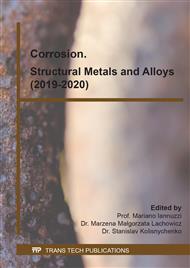[1]
R. Kuwae, K. Sato, H. Emiko, K. Junko, S. Nakamura, Mechanism of Zircaloy Nodular Corrosion, J. Nucl. Mater. 119 (1983) 229~239.
DOI: 10.1016/0022-3115(83)90199-x
Google Scholar
[2]
J. P. Pemsler, Diffusion of oxygen in zirconium and its relation to oxidation and corrosion, Electrochem. Soc. 105 (1958) 315-322.
DOI: 10.1149/1.2428734
Google Scholar
[3]
B. Cox, Some thoughts on the mechanisms of in-reactor corrosion of zirconium alloys, J. Nucl. Mater. 336 (2005) 331-368.
DOI: 10.1016/j.jnucmat.2004.09.029
Google Scholar
[4]
K. Forsberg, M. Limbäck, A. R. Massih, A model for uniform Zircaloy clad corrosion in pressurized water reactors, Nucl. Eng. Des. 154 (1995) 157-168.
DOI: 10.1016/0029-5493(94)00915-l
Google Scholar
[5]
T. Y. Park, S. J. Yoo, B. K. Choi, Y. H. Jeong, Corrosion and oxide characteristics of Zr-1.5Nb-0.4Sn-0.2Fe-0.1Cr alloys in 360°C pure water and LiOH solution. J. Nucl. Mater. 373 (2008) 343-350.
DOI: 10.1016/j.jnucmat.2007.06.015
Google Scholar
[6]
Y. Matsuda, H. Anada, H. E. Bishop, 18O Tracer study of the oxidation of zircaloy-4 in steam, Surf. Interface Anal. 21 (1994) 349-355.
DOI: 10.1002/sia.740210605
Google Scholar
[7]
N. Ni, S. Lozano-Perez, M. L. Jenkins, C. English, G. D. W. Smith, J. M. Sykes, C. R. M. Grovenor, Porosity in oxides on zirconium fuel cladding alloys and its importance in controlling oxidation rates, Scripta. Mater. 62 (2009) 564-567.
DOI: 10.1016/j.scriptamat.2009.12.043
Google Scholar
[8]
V. Pawar, C. Weaver, S. Jani, Physical characterization of a new composition of oxidized zirconium-2.5 wt% niobium produced using a two step process for biomedical applications, Appl. Surf. Sci. 257 (2011) 6118–6124.
DOI: 10.1016/j.apsusc.2011.02.014
Google Scholar
[9]
M. Mosbacher, F. Scherm, U. Glatzel, Oxygen diffusion kinetics of an advanced three step heat treatment for zirconium alloy ZrNb7, Surf. Coat. Technol. 339 (2018) 139-146.
DOI: 10.1016/j.surfcoat.2018.02.015
Google Scholar
[10]
D. Gosset, M. Le Saux, D. Simeone, D. Gilbon, New insights in structural characterization of zirconium alloys oxidation at high temperature, J. Nucl. Mater. 429 (2012) 19-24.
DOI: 10.1016/j.jnucmat.2012.05.003
Google Scholar
[11]
A. Couet, A. T. Motta, A. Ambard, The coupled current charge compensation model for zirconium alloy fuel cladding oxidation: I. Parabolic oxidation of zirconium alloys, Corros. Sci. 100 (2015) 73-84.
DOI: 10.1016/j.corsci.2015.07.003
Google Scholar
[12]
J. Wei, P. Frankel, E. Polatidis, M. Blat, A. Ambard, R. J. Comstock, L. Hallstadius, D. Hudson, G. D. W. Smith, C. R. M. Grovenor, M. Klaus, R.A. Cottis, S. Lyon, M. Preuss, The effect of Sn on autoclave corrosion performance and corrosion mechanisms in Zr–Sn–Nb alloys, Acta Mate. 61 (2013) 4200-4214.
DOI: 10.1016/j.actamat.2013.03.046
Google Scholar
[13]
A. Yilmazbayhan, E. Breval, A. T. Motta, Transmission electron microscopy examination of oxide layer formed on Zr alloys, J. Nucl. Mater. 349 (2006) 265-281.
DOI: 10.1016/j.jnucmat.2005.10.012
Google Scholar
[14]
J. Y. Park, B. K. Choi, S. J. Yoo, Y. H. Jeong, Corrosion behavior and oxide properties of Zr-1.1wt% Nb-0.05wt% Cu alloy, J. Nucl. Mater. 359 (2006) 59–68.
DOI: 10.1016/j.jnucmat.2006.07.017
Google Scholar
[15]
G. P. Sabol, S. B. Dalgaard, The origin of the cubic rate law in zirconium alloy oxidation, Electrochem. Soc. 122 (1975) 316-317.
DOI: 10.1149/1.2134204
Google Scholar
[16]
H. E. Evans, D. J. Norfolk, T. Swan, Perturbation of parabolic kinetics resulting from the accumulation of stress in protective oxide layers, Electrochem. Soc. 125 (1978) 1180-1185.
DOI: 10.1149/1.2131644
Google Scholar
[17]
C. C. Dollins, M. Jursich, A model for the oxidation of zirconium-based alloys, J. Nucl. Mater. 123 (1983) 19-24.
Google Scholar
[18]
M. Tupin, M. Pijolat, F. Valdivieso, M. Soustelle, A. Frichet, P. Barberis, Differences in reactivity of oxide growth during the oxidation of Zircaloy-4 in water vapour before and after the kinetic transition, J. Nucl. Mater. 317 (2003) 130-144.
DOI: 10.1016/s0022-3115(02)01704-x
Google Scholar
[19]
T. Pauporte, J. Finne, Impedance spectroscopy study of anodic growth of thick zirconium oxide films in H2SO4, Na2SO4 and NaOH solutions, J. Appl. Electrochem. 36 (2006) 33-41.
DOI: 10.1007/s10800-005-9011-0
Google Scholar



